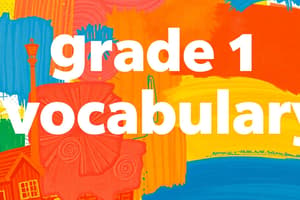Podcast
Questions and Answers
What is the main purpose of imperative sentences?
What is the main purpose of imperative sentences?
to give commands, instructions, or requests
What punctuation mark is often used at the end of an exclamatory sentence?
What punctuation mark is often used at the end of an exclamatory sentence?
exclamation mark
What is the typical structure of an imperative sentence?
What is the typical structure of an imperative sentence?
a subject and a base form verb
What is the benefit of understanding imperative and exclamatory sentences for students?
What is the benefit of understanding imperative and exclamatory sentences for students?
What type of sentence is 'Close the door!'?
What type of sentence is 'Close the door!'?
What type of sentence is 'Wow, I love this cake!'?
What type of sentence is 'Wow, I love this cake!'?
Study Notes
Classifying the Sentence (Imperative or Exclamatory) in English for Grade 1
The ability to classify sentences according to their form and function is a fundamental skill that children develop as they learn the English language. In grade 1, students are introduced to various aspects of sentence structure, including identifying different types of sentences. Two common sentence forms are imperative sentences and exclamatory sentences. Understanding these sentence types will help students improve their reading comprehension and writing skills.
Imperative Sentences
Imperative sentences are used to give commands, instructions, or requests. They are typically structured as a subject and a base form verb. For example:
- Close the door.
- Bring me a book.
- Don't touch the stove.
Exclamatory Sentences
Exclamatory sentences are used to express strong emotions, surprise, or excitement. They often have an exclamation mark at the end. For example:
- Wow, what a beautiful sunset!
- He got a new puppy!
- I can't believe it's raining cats and dogs!
Practice Exercises
To help students practice classifying sentences, teachers can provide fun exercises and activities. Here are some examples:
-
Read aloud: "The cat sat on the mat."
- Question: Is this an imperative or exclamatory sentence?
- Answer: This is an imperative sentence.
-
Write a sentence using the word "imagine":
- Sentence: "Imagine if we could fly like birds."
- Question: Is this an imperative or exclamatory sentence?
- Answer: This is an exclamatory sentence.
-
Draw a picture of a dog and write a sentence about it:
- Sentence: "Look at my cute dog."
- Question: Is this an imperative or exclamatory sentence?
- Answer: This is an exclamatory sentence.
Conclusion
Understanding the difference between imperative and exclamatory sentences is an important skill for grade 1 students to develop. By practicing these sentence types, students will improve their reading comprehension and writing skills, which will benefit them throughout their academic journey.
Studying That Suits You
Use AI to generate personalized quizzes and flashcards to suit your learning preferences.
Description
This quiz focuses on helping grade 1 students classify sentences as imperative or exclamatory. It covers the definitions and examples of both sentence types, providing practice exercises for better understanding and application. By mastering this skill, students can improve their English language comprehension and writing abilities.




